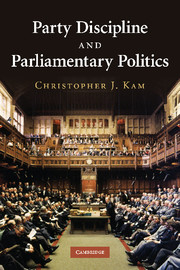Book contents
- Frontmatter
- Contents
- List of figures
- List of tables
- Acknowledgements
- 1 Introduction
- 2 A model of intra-party politics
- 3 Patterns of backbench dissent in four Westminster parliamentary systems, 1945–2005
- 4 Policy preferences and backbench dissent in Great Britain and Canada
- 5 Dissent, constituency service, and the personal vote in Great Britain and New Zealand
- 6 The cost of dissent to the party
- 7 Demotion and dissent in the Canadian Liberal Party, 1991–1997
- 8 Discipline and dissent in the Australian Coalition, 1996–1998
- 9 Career trajectories, socialization, and backbench dissent in the British House of Commons
- 10 Conclusion
- Appendix 1 Comparative statics and proofs
- Appendix 2 Content and construction of ideological scales
- Appendix 3 Sampling and coding of media dissent and discipline
- Appendix 4 Demotion and the parliamentary careers of Canadian MPs
- References
- Index
Appendix 3 - Sampling and coding of media dissent and discipline
Published online by Cambridge University Press: 03 July 2009
- Frontmatter
- Contents
- List of figures
- List of tables
- Acknowledgements
- 1 Introduction
- 2 A model of intra-party politics
- 3 Patterns of backbench dissent in four Westminster parliamentary systems, 1945–2005
- 4 Policy preferences and backbench dissent in Great Britain and Canada
- 5 Dissent, constituency service, and the personal vote in Great Britain and New Zealand
- 6 The cost of dissent to the party
- 7 Demotion and dissent in the Canadian Liberal Party, 1991–1997
- 8 Discipline and dissent in the Australian Coalition, 1996–1998
- 9 Career trajectories, socialization, and backbench dissent in the British House of Commons
- 10 Conclusion
- Appendix 1 Comparative statics and proofs
- Appendix 2 Content and construction of ideological scales
- Appendix 3 Sampling and coding of media dissent and discipline
- Appendix 4 Demotion and the parliamentary careers of Canadian MPs
- References
- Index
Summary
This appendix describes how I sampled and coded reports of media dissent and party discipline employed in Chapters 5 and 8.
Sample selection
I tracked media dissent and party discipline through several major dailies in Canada, Australia, and New Zealand, trying to balance the needs for regional coverage and quality reporting.
Reports of media dissent and party discipline in Australia were tracked in three sources: (1) Sydney Morning Herald – the major source; (2) The Age (Melbourne) – for Victorian MPs and Senators; (3) West Australian (for West Australian MPs and Senators). MPs' names were used as search terms in each database. Newspaper stories appearing between 1 May 1996 and 30 September 1998 were coded for dissent and duplicates weeded out.
Canadian media dissent and party discipline reports were tracked in the following sources: (1) Southam Newspapers (Vancouver Sun, Calgary Herald, Winnipeg Free Press, Toronto Star, Ottawa Citizen, Montreal Gazette, and Halifax Daily News); (2) Globe and Mail; (3) La Presse. As in the Australian case, MPs' names were used as search terms in the above databases. The Canadian sampling frame dated from 5 November 1993 to 30 April 1997. The Canadian media databases were more flexible than the Australian databases (primarily because Southamowns newspapers in a number of urban centres) and permitted more geographically sensitive searches. I could, for example, search for a Quebec MP's name in the Montreal Gazette or La Presse instead of relying solely on the Globe and Mail (essentially the Canadian counterpart to the Sydney Morning Herald).
- Type
- Chapter
- Information
- Party Discipline and Parliamentary Politics , pp. 238 - 242Publisher: Cambridge University PressPrint publication year: 2009



